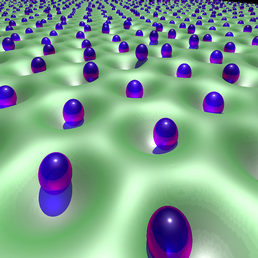24th November 2009 4 p.m. 53/4025
Modelling interacting objects in High Temperature Superconductors
Dr Hans Fangohr
University of Southampton
- Web page
- http://cmg.devel.mauveinternet.co.uk/people/fangohr/
- Categories
- Agents, C++, Iridis, Linux, Materials, Molecular Dynamics, Povray, Python, Superconductivity
- Submitter
- Hans Fangohr

Pancake vortices (represented by blue spheres) form a hexagonal lattice. The underlying potential (green) represents the cumulative effect of pancake vortices in other layers. Below the melting temperature, the layers -- of which only one is shown -- stabilise each other.
High Temperature Superconductors are penetrated by magnetic fields in the form of flux lines (which are also called vortices). These can be described as discrete particles with a (repulsive) interaction potential between them.
I will describe how Molecular Dynamics (in particular Langevin Dynamics) techniques are used to study the dynamics and statics of these systems of interacting vortices.
If one only takes into account the vortex-vortex interaction, then the equilibrium configuration is a hexagonal lattice (at zero Temperature). There is rich physics in this complex system, when we disturb this ground state, for example through
-
finite temperatures
-
a disordering pinning potential (stemming from material inhomogeneities)
-
a force driving the vortices in some direction (originating from an electric current)
I will try to describe both the vortex state and the simulation techniques in sufficient detail and generic terms suitable for a general audience, followed by a discussion of the different emerging static and dynamic phases of this system.